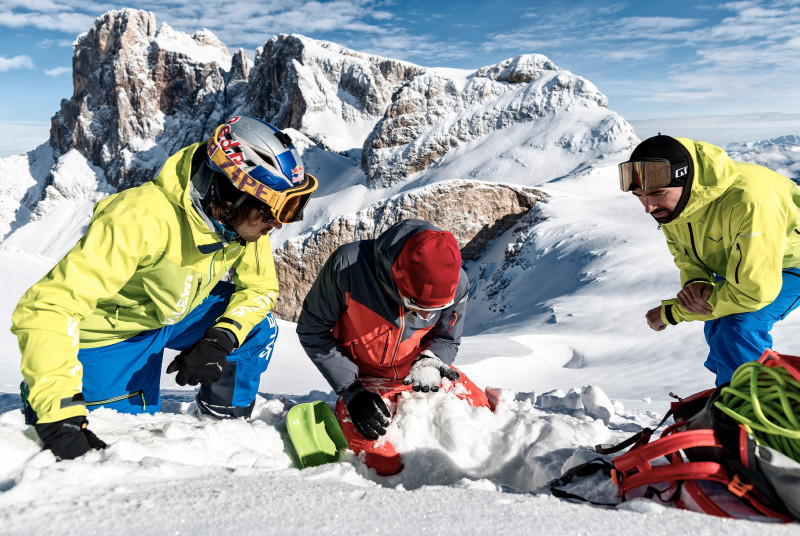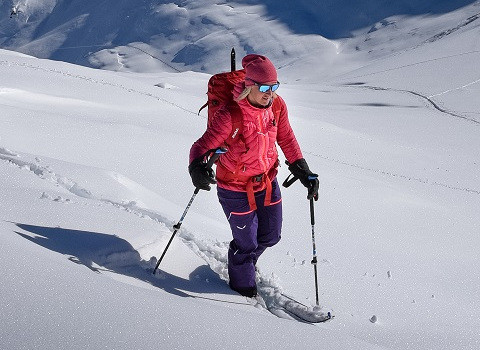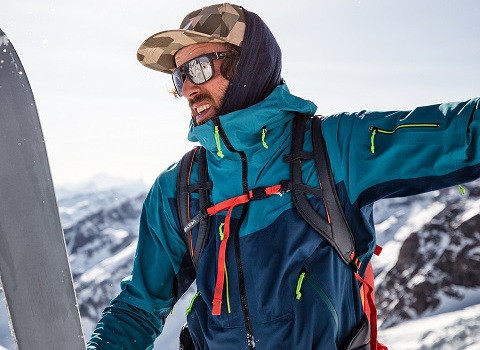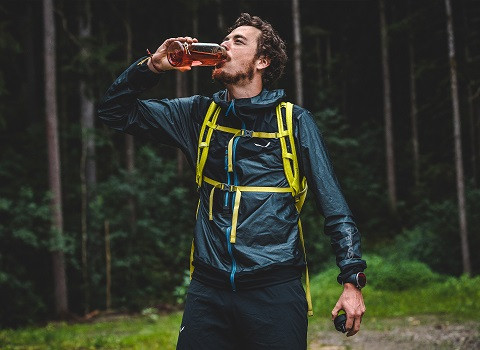expert advice / alpine mountaineering
AVALANCHE SAFETY: ALL YOU NEED TO KNOW
1. Avalanche Safety: all you need to know
Avalanches happen at particular times, and in particular places, for particular reasons. Natural avalanches can occur, but there are almost always obvious signs before avalanches come down on their own.
Avalanche victims are often highly skilled in their sport, but have little knowledge of or the skills for dealing with avalanches. 90% of avalanches are triggered by the victim or someone in their own party.
Knowledge is power. You need to be your own avalanche expert. Both for yourself and your partners. By learning about avalanches, you can maximise your chances of avoiding getting caught by one.
This article provides a starting point for some of the basic information you need to know for the backcountry. Ultimately though, there is no substitute for attending an avalanche awareness course with a professional mountain guide.
2. Avalanche Safety Skills
The best defence against avalanches is to learn how avalanches work and how to avoid them. Take the guesswork out of going into the backcountry by being able to read the conditions and make good decisions.
2.1 First up, get the forecast
Always go out with an avalanche safety plan based on the forecast.
Make sure that you properly understand the local avalanche forecast, the local snow, the danger ratings, any potential issues as well as the recent past, current, and anticipated weather and snow conditions.
Remember: low and moderate danger ratings do not mean no danger. Avalanche danger is complicated and the danger rating is just the beginning.
2.2 Types of Avalanches
There are many different types of avalanches:
2.2.1 Loose Snow Avalanches
Loose snow avalanches occur where there is little or no cohesion in the snowpack. In winter, loose snow avalanches usually happen during or after it has snowed.
In warmer months, wet loose snow avalanches are usually caused by meltwater or rain.
If you see any signs of instability or start sinking past your ankles into soft snow, it’s time to get away from steep slopes.
2.2.2 Slab Avalanches
Slab avalanches are when a layer of snow breaks away from the layer beneath it and slides downhill. Slab avalanches are the most common – and most dangerous – type of avalanches faced by backcountry travellers.
Snow is broken up by the wind and then re-deposited. Slab is deposited in layers very quickly and its hardness varies depending on wind speed, temperature and humidity. Some layers settle and become stronger, while others grow weaker and others cannot bond to them.
An avalanche is caused when the top layer of snow – the slab – is not bonded to the layer underneath and then is disturbed by some kind of trigger, often a skier or climber. Slabs usually start at a fracture line running across the top of the slide and are bigger and deeper.
2.2.3 Cornice hazards
Cornices are formed when wind blows snow over a sharp terrain feature like a ridge. Snow collects and piles up, often overhanging and fragile, on the leeward side. Even small cornices can be dangerous because they can collapse to pull you over a cliff or trigger an avalanche.
1. Avalanche Safety: all you need to know
2.1 First up, get the forecast
3. Contributing Factors to Avalanches
4. Avalanche Safety Tips to Help Reduce Risk
4.1 Understand and use the Graphical Reduction Method (GRM)
4.2 Tips if you find yourself in Avalanche Hazard Territory:
3. Contributing Factors to Avalanches
3.1 Terrain
3.2 Slope angle
Avalanches occur most frequently in steep terrain on slopes between 30° and 45°. When you’re skiing or climbing, assess your immediate surroundings – is your route particularly snow laden? Can you avoid steep avalanche prone angles?
3.3 Slope aspect
in different ways and avalanche danger can change a lot as you move from aspect to aspect. In winter, south-facing slopes are more stable than north-facing ones since they are exposed to the sun, which melts and compactes the snow.
North-facing slopes tend to be less stable than south–facing slopes over the winter. This is because they are more likely to have unstable layers of dry, icy ‘hoar’ snow that is unable to bond with other layers. They also don’t see much sun that can warm and condense the snow.
In spring and early summer, south-facing slopes can experience serious melting that may result in dangerous wet snow slides. The warmer weather in these seasons often allows the snow on north–facing slopes to consolidate, which means they can be safer.
3.4 Elevation
Avalanche danger typically changes with elevation. Danger is often, but not always, greater at higher elevations.
3.5 Terrain traps
Snowpack is likely to be unstable in certain areas. Are there any oblivious terrain traps; convex slopes or gullies and exposed traverses above large open slopes or cliff bands? You’re better off avoiding bowls, cirques and depressions where snow could settle after a slide.
3.6 Weather
New snow is combined with wind or with a rapid rise in temperature can contribute to a high avalanche hazard. Large amounts of snow falling in a short time may cause conditions when the snowpack will slide. Heavy snowfall with wet or dense snow over lighter powder snow can create layers of instability. Rain often runs down through the snowpack, making the layers more likely to slide.
3.7 Temperature
Fluctuating temperature can cause problems with snowpack stability. Temperature differences can cause changes in how the layers in the snowpack form. In spring, rapid warming may cause avalanches when the cold winter snowpack is warmed for the first time.
3.8 Snowpack
Snowstorms pile up snow in the mountains all winter long. When snow consistency remains constant, the snowpack is homogenous and stable. However, when the snowpack develops different layers of different snow types it becomes unstable and dangerous.
As a backcountry skier or mountaineer, use the avalanche reports to find out about the deepest deposits. Have weak layers within the snowpack been highlighted? Has wind slab formed? Have fluctuating temperatures affected the snowpack stability? Take the time to understand the on-snow conditions and test the layers of the snowpack for stability. This is especially important on slopes between 30 and 45 degrees.
3.9 The human factor
Terrain, weather and snowpack play a huge role in contributing to the chances of triggering an avalanche. However, even if you have all the information at your fingertips, there’s one further important avalanche safety factor to consider: people.
Who's in your party? What’s their level of fitness and experience and their weight on the snowpack? What equipment are you carrying? Do you all have transceivers, shovels and probes?
Are ego and ambition likely to cloud your judgement and impair decision-making? It doesn’t matter whether you’re a weekend warrior or on the expedition of a lifetime, your decisions should be the same. Go with your gut feeling, and respect the views of everyone in the party. Always try to assess the situation as if you were moving alone. If you do not feel happy, speak up.
Here are a couple of point to consider with your party’s decision-making:
- Existing tracks: Just because someone else went across a slope or through an area before you, this does not make it safe. Tracks in the snow can give a false sense of security. Don’t rely on them.
- Home turf: If you are in terrain that you’re familiar with, you might be tempted to take greater risks. However, conditions change rapidly from day-to-day and even minute-to-minute, so don’t be complacent and stay alert.
- Remember: slopes close to the lifts with regular high traffic are going to be more stable than slopes with no – or only occasional – traffic. So, don’t apply information you know from safer areas to not so frequently skied zones.
- Follow your own judgement: Be aware of pushing too hard (overcommitment) or focussing excessively on your objective, “summit fever”. The same applies to blue alpine dawns and fine powder days – don’t let the conditions cloud your judgment.
- Be honest and be a healthy sceptic: Just because someone in your party seems to be more experienced than you, don’t take anything for granted. It’s better to openly discuss what experience you all have.
4. Avalanche Safety Tips to Help Reduce Risk
- Preparation: Use maps, guidebooks and local knowledge (social media) to check your intended route. Pay particular attention to slope angles, aspects, altitudes, avalanche reports, avalanche blackspots and recent history.
- Weather. How are conditions on the day? Do you have good visibility? Is it cold or unusually warm? Is it snowing or raining? Is there a strong wind at altitude transporting snow? Is strong sunlight an issue? How are the slopes and cornices behaving?
- Terrain. Can you avoid steep avalanche prone angles? (30° - 45°). Are your slope aspects affected by strong sunlight? How much snow is there at your altitude? Avoid terrain traps; bowls, cirques and depressions where snow could settle, convex slopes, cliff bands, boulders or trees where the snowpack breaks, wind-loaded slopes.
- Snowpack. Where and how much snow cover is there? How does the snow feel? Are there any obvious changes in colour or texture - such as areas of hail and ice? Recent avalanche debris on similar slopes is a big clue to stability.
- Probably the biggest thing you could do to reduce your risk is to improve your own backcountry avalanche awareness and rescue skills. For example, by attending a course.
4.1 Die Grafische Reduktionsmethode (GRM)
- Risik 1: Check the risk on your route
- Risik 2: Evaluate the terrain around you in a radius of about 20 metres
- Risik 3: Consider the whole environment around you (entire mountain slope)
- Risik 4: Check if the road you are travelling into your area by car is safe
- Risik 5: Check if the location (house, hut, bivouac) you are staying at is safe
4.2 Tips if you find yourself in Avalanche Hazard Territory:
- Look for escape routes.
- Follow ridges and buttresses
- Follow wind scoured ground
- Traverse high – under buttresses or low – below runout zones
- Cross suspect slopes one at a time, aim for rocky islands of safety
- Get your rope out and belay each other from a solid anchor (if practicable)
4.3 The Gear You Need
If you get caught in an avalanche, having the right avalanche safety gear can make all the difference. If you get buried, having the right gear makes it more likely that your partners can find you and that you will survive. Your essential avalanche gear:
- Transceiver
- Pack
- Shavel
- Probe
- Helmet
Transceiver
An avalanche transceiver is probably the most important thing you need to carry to find a buried partner or them to find you.
Transceivers are often called beacons, but don’t confuse them with a personal locator beacon, which will not help locate a partner in an avalanche. Everyone in your party needs to carry a transceiver to be able to search and be found. If you get caught and buried by an avalanche, it’s very unlikely you’ll be found without one.
The best beacon is the one you are familiar with and that you can use effectively. Make sure yours is a recent model. Test it before you head out, carry it somewhere safe and don’t forget to turn it on.
Probe
Your transceiver gets you close to a buried partner. Use your probe to pinpoints their location. Probes are collapsible and extend and lock to form a rigid rod. Everyone in your party should carry a probe. Probes should be at least 240 cm long.
Knowing how to use a probe properly is important. If you’re not sure, don’t bluff or you could be putting someone’s life at risk. Get some proper avalanche training.
Shavel
Digging out a buried partner out is hard work. And time is critical. This means that good technique is important. Metal shovels are best, as plastic shovels can bend or break.
Everyone in your party should carry an avalanche shovel. So that they can help dig a buried partner out. Make sure you can assemble your shovel quickly and check the locking mechanism a few times a season.
Pack
So, you need a pack to carry your avalanche safety gear. However, wearing a pack might also increase your chances of floating in an avalanche and can also protect you from impact. Always keep your pack with you and securely strapped on your back. If you get caught in an avalanche, you’ll probably need the gear you’re carrying anyway, so you don’t want to be separated from it.
Ideally, your pack should have a dedicated rescue compartment for your shovel and probe so that you can get to it fast in the event of an emergency. Always carry your beacon on your body, never in your backpack, in case you get separated from it.
Some packs also come with an inflatable airbag. because it can help you float on top of an avalanche, increasing your odds of surviving.
Helmet
A good helmet should be light, warm, comfortable, and provide your head protection from trauma. For skiing and snowboarding, your helmet should be certified for EN 1077 certification. For mountaineering, EN 12492 and UIAA 106 are the certifications to look for. If you plan to use your brain on a regular basis, there is no excuse for not wearing a helmet.
Other equipment
If you get stuck after an avalanche, say due to injuries or lost gear, we also recommend that you carry these items with you: first aid kit (and know how to use it), mobile phone, extra warm layers (down jacket), head lamp, emergency shelter (bivvy bag), spare batteries, food and hot drinks. Other avalanche safety gear you might also want to consider is a satellite navigation device, commonly known as a GPS receiver, and a mobile phone with an offline map and power pack.
It kind of goes without saying though that buying and carrying the gear is not enough in itself. You need to make sure that it’s all working and that you know how to use it. And that you travel with people who also have the same gear and who know how to use it. Get the knowledge and keep your skills fresh.
Related Topics
HOW TO LAYER FOR SKI MOUNTAINEERING
Ski mountaineering is an intense activity. Moving through the mountains in winter means that you need to take everything that you need with you.
PLANNING YOUR FOOD FOR HIKING MOUNTAINS
Food is your fuel for any high-output activity, and mountaineering is certainly the kind of activity where what you eat will have a direct effect on your performance and endurance.
HOW TO GET INTO SKI TOURING
Ski touring is a type of backcountry skiing, also called alpine touring or Randonnée. Ski touring makes use of special adapted touring skis and touring bindings that convert from free-heel to fixed-heel mode.





